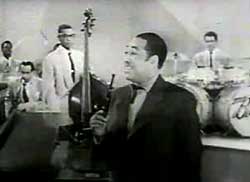 The great Edward Kennedy "Duke" Ellington & His Orchestra, on this three-minute Snader Telescription, perform V.I.P.'s Boogie (1951).
The great Edward Kennedy "Duke" Ellington & His Orchestra, on this three-minute Snader Telescription, perform V.I.P.'s Boogie (1951).
Duke introduces the song personally, standing with microphone in hand, sweetly assuring us, "Very important persons naturally means you," us, the people who love his music. This number he informs us is used as "an excuse for a bit of name calling," meaning introductions.
He then begins introducing select members of the band, one by one, each getting a little solo performance before Duke introduces the next musician -- Harry Carney on bass clarinet, & Jimmy Hamilton on clarinet.
Introductions & solos continue for Wade Cook with trumpet blasts, Paul Gonsalves a Latino guy on sax wailing on sax, the gentlemanly gaze of Britt Woodman on trumbone, Russell Procope (who almost leaves his place in the bandbox prematurely), Cat Anderson with high-note trumpet, Quentin Jackson on mute trumbone using a literal toilet splunger to get the wah wah sound, &Willie Smith another white guy on sax.
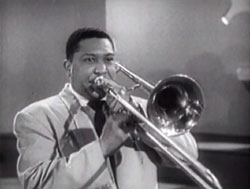 Having an integrated band was actually chance-taking & daring at the time. It was outright illegal under Jim Crow laws in the south. Having an integrated band was actually chance-taking & daring at the time. It was outright illegal under Jim Crow laws in the south.
So when bands like Basie's & Ellington's refused to be segregated bands, these were bold decisions because repurcussions had to be expected. Ellington was a lifelong activist, & it even came out in the music in such compositions as his "Black Beige & Brown Suite," "Black & Tan Fantasy," & much else, including for the hundredth anniversary of the Emancipation Proclamation his homage to Dr. King, "King Fit the Battle of Alabama."
Each of the solos in V.I.P.'s Boogie are on the up side of amazing. Then Cat overlapping Willie proves his previous high notes weren't nearly high enough!
Any type of soundie or transcription with Duke Ellington is going to be good, but this one's a bit special for the individual introductions & the fact that not even one example in this chain of solo moments is anything less than spectacular.
All the Snader telescriptions can be hand on the compilation The Big Bands: The Snader Telescriptions Volume I: Duke Ellilngton & Lionel Hampton (1988 vhs, 2000 dvd) which also has all but one of Hampton's telescriptions. This was also issued as Swing Era: Duke Ellington, Lionel Hampton (2004) & as Jazz-O-Logy: Hamp & the Duke (2004).
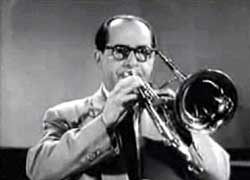 Another of Duke's telescriptions is Caravan (1952). Several excellent solo moments (Ray Nance on violin, Jimmy Anderson's clarinet, a trumpet lead from Cat Anderson in the back row) are scattered through four minutes of performance. Another of Duke's telescriptions is Caravan (1952). Several excellent solo moments (Ray Nance on violin, Jimmy Anderson's clarinet, a trumpet lead from Cat Anderson in the back row) are scattered through four minutes of performance.
But the greatest of these solos by the song's composer Juan Tizol, on valve trumbone. He gives it a truly exotic desert romance sense, really an ideal composition for his instrument.
This particular Snader telescription came with the copyright date 1950 on the opening credits card, but I think Willie Smith began recording with Ellington in 1951, & all the Ellington sessions for the Snaders were in Los Angeles on March 14, 1952.
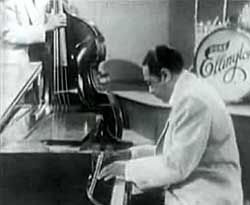 The jukebox soundies of the previous decade were pre-recorded with singers lip-syncing & bands hoping to match their silently filmed performance to the pre-recorded performance, so they dared not experiment or interpret or the visual wouldn't match up with the audio.
The jukebox soundies of the previous decade were pre-recorded with singers lip-syncing & bands hoping to match their silently filmed performance to the pre-recorded performance, so they dared not experiment or interpret or the visual wouldn't match up with the audio.
The Snader transcriptions of the new decade, however, are genuine live performances & some of them are considered fairly important recordings, including Mood Indigo (1952), which is an arrangement unique to this performance.
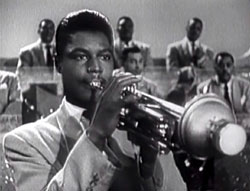 The Billy Strayhorn composition begins with an experimental rampage on Ellington's piano, then right into the slow melodic trombones (Quentin Jackson & Britt Woodman) & bass clarinet (Harry Carney). The Billy Strayhorn composition begins with an experimental rampage on Ellington's piano, then right into the slow melodic trombones (Quentin Jackson & Britt Woodman) & bass clarinet (Harry Carney).
Enter a calm Jimmy Hamilton for a mellow clarinet solo, followed by that handsome clothing horse Wade Cook with a muted trumpet solo, & concluding with Duke's solo.
Ah, the beauty of it. It's like a dream. I have a dark blue rhododendron azalea growing in my garden, a cultivar named "Mood Indigo" after the Ellington classic. When in full bloom, it really does just about equal the beauty of Ellington, the man & the song.
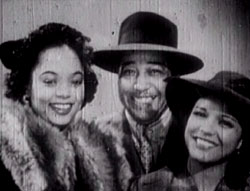 Staged as though it's an impromptu performance after hours at the Harlem Cats Eatery, Duke Ellington & His Orchestra star in Jam Session (1942). A sign on the staircase informs us musicians (who were notoriously without funds) could get a meal for twenty-three cents.
Staged as though it's an impromptu performance after hours at the Harlem Cats Eatery, Duke Ellington & His Orchestra star in Jam Session (1942). A sign on the staircase informs us musicians (who were notoriously without funds) could get a meal for twenty-three cents.
Ellington made five soundies released in 1942, the filming beginning about mid-November of '41. These would be the last time Ellington was filmed with the Blanton-Webster Band, though already bassist Jimmy Banton has left, & Ben Webster would soon leave as well (but later rejoining Duke's orchestra).
Duke's orchestra & the Blanton-Webster Band were one & the same from 1939 to 1942, helping sustain a high watermark for Duke's arrangements.
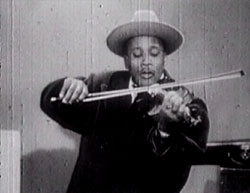 Jam Session is a wonderful jukebox soundie with moments showcasing Ray Nance on violin, Rex Stewart on trumbone, Ben Webster on sax, Joe "Tricky Sam" Nanton on trombone with a toilet splunger for wah-wah effects. Jam Session is a wonderful jukebox soundie with moments showcasing Ray Nance on violin, Rex Stewart on trumbone, Ben Webster on sax, Joe "Tricky Sam" Nanton on trombone with a toilet splunger for wah-wah effects.
The round of solos continues with Barney Bigard on clarinet, then young Sonny Greer arrives late to start knockin' 'em down on his drum kit. A rarity for bands in soundies, each solo artists get their names put up on the screen as subtitles, as each really was a big star in his own right.
The number is actually called "C Jam Blues" & gives everyone their moment in the moonlight. As the camera follows around the cafe from performer to performer, people start wandering in from the street, including some babes, two of whom Duke leaves with at the end, winking at us before he's gone.
In 2001, Jam Session was added to the National Film Treasury catalog of American films with cultural importance. Since I'm a great lover of soundies, it is just so great to see the National Film Preservation Board took notice too.
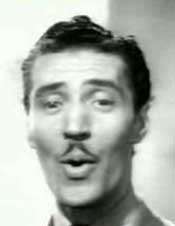 Flamingo (1942) is a fine example of how very much can be fitted into a single three-minute soundie. Not all soundies honestly rise to the level of quality cinema but this one's a great short-subject. Flamingo (1942) is a fine example of how very much can be fitted into a single three-minute soundie. Not all soundies honestly rise to the level of quality cinema but this one's a great short-subject.
Duke Ellington & His Orchestra perform with Herb Jeffreys (or Jeffries), who literally gave up a film career in order to go on the road as Duke's vocalist.
He'd been making black-cast westerns such as The Bronze Buckeroo (1938) & others. He cancelled all film projects in favor of his music, & singing for Ellington's band exceeded most any singer's ambition.
He remained forever after known as "the Bronze Buckeroo" & regarded as a western swing singer, but of course for Ellington he sang a smooth swing jazz, generally on the romantic side.
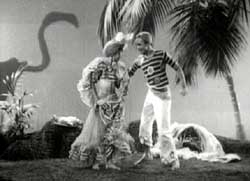 The crooner's vocal solo begins: "Flamingo, like a flame in the sky/ Flying over the island/ To my lover nearby." The crooner's vocal solo begins: "Flamingo, like a flame in the sky/ Flying over the island/ To my lover nearby."
Like so many fine Ellington numbers, it has the feel of far off exotic places of beauty & romance. Duke gazes with such admiration at Herb.
Jump-cut to a little set evoking a tropical island -- we see dancers Janet Collins & Talley Beatty of the Katherine Dunham dance troup, playing island maiden & sailor in such a hot erotic piece of choreography.
Dunham's dancers appear in a many films & Katherine Dunham herself is highlighted in a shockingly beautiful sequence in Stormy Weather (1943).
The dancers pretty much make this soundie their own, & stealing the spotlight from a couple guys like Ellington & Jeffreys takes a lot of gumption.
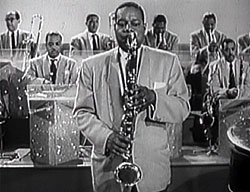 The Snader telescription Sophisticated Lady (1952), is done as an instrumental. It was composed by Mitchell Parish, Duke Ellington & Irving Mills. This arrangement begins with Harry Carney slow, deep, very low bass clarinet solo over which other instruments section by section layer themselves.
The Snader telescription Sophisticated Lady (1952), is done as an instrumental. It was composed by Mitchell Parish, Duke Ellington & Irving Mills. This arrangement begins with Harry Carney slow, deep, very low bass clarinet solo over which other instruments section by section layer themselves.
It's a stunning close-dance number, & I suddenly thought of Barry White whispering in a sweethearts ear. The bass clarinet is a sexy instrument, looking a bit like a giant stretched out sax.
Ellington's piano is the last instrument to join the arrangement, just as the camera shifts to his profile. The bass player is immediately behind the piano.
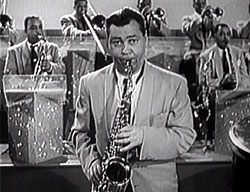 When the camera jump-cuts back to a sax player, it's a different guy, Willie Smith, & he's playing alto sax, a rather a witty piece of editing since he's standing precisely where Carney had been standing. When the camera jump-cuts back to a sax player, it's a different guy, Willie Smith, & he's playing alto sax, a rather a witty piece of editing since he's standing precisely where Carney had been standing.
The edit takes us back to Ellington from a new camera angle that shows his drummer Louie Bellson in the background. The Snader Telescriptions are the only films in which Bellson is a regular part of the orchestra.
Telescriptions rarely set up so many good camera angels, so a bit more inspiration went into the Ellington mini-films.
The schedule was nevertheless swift as all the telescriptions were filmed in a single day. Ellington was paid $1,000, plus the band members worked for scale ($84 to $105 each) which was a big budget as telescriptions go, & director Duke Goldstone clearly wanted to make them as good as he could make them visually.
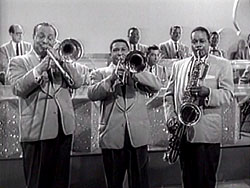 Duke starts off Solitude (1952) with a few tinkles of the keys, before Quentin Jackson & Britt Woodman on trumbones & Carney's bass clarinet begins the smooth, smooth melody.
Duke starts off Solitude (1952) with a few tinkles of the keys, before Quentin Jackson & Britt Woodman on trumbones & Carney's bass clarinet begins the smooth, smooth melody.
It's another romantic slow dance with special focus on Carney, at first alongside Quentin Jackson & Britt Woodman with trombones, but soon soloing with amazing beauty.
The camera jump-cuts from orchestra to Jimmie Grissom standing alone, singing: "In my solitude, you haunt me/ With reveries of days gone by/ In my solitude you taunt me/ With memories that never die/ I sit in my chair/ Filled with despair/ Nobody could be so sad with gloom everywhere/ I sit & stare/ I know I'll soon go mad in my solitude...."
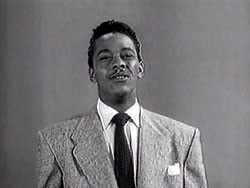 These poetic lyrics fit to an equally poetic melody. The song was written by Duke Ellington, Eddie De Lange & Irving Mills. It was also recorded by Billie Holiday, Sarah Vaughan & Johnny Mercer. Lyricist Eddie De Lange had also written "Moonglow" with Will Hudson while he helped head up the Hudson-DeLange Orchestra. These poetic lyrics fit to an equally poetic melody. The song was written by Duke Ellington, Eddie De Lange & Irving Mills. It was also recorded by Billie Holiday, Sarah Vaughan & Johnny Mercer. Lyricist Eddie De Lange had also written "Moonglow" with Will Hudson while he helped head up the Hudson-DeLange Orchestra.
Though spelled Jimmie on the Snader telescription title card, his name is more often given as Jimmy Grissom. There's a smooth-jazz sweetness in his voice.
In the late '40s he had his own combo out of Los Angeles, & performed in a young upstart Las Vegas. With Ellington he recorded such numbers as "Vagabonds," "Do Nothing Till You Hear from Me," "I'm Just a Lucky So & So" & "What More Can I Say."
He had the perfect swing-band voice falling halfway between a totally smooth crooner & a rougher edged bluesman, a blend that lent him originality.
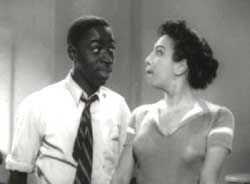 With the Duke Ellington orchestra backing them up, singer-dancers Marie Bryant & Paul White peform on Bli-Bip (1942), a number written by Duke Ellington with lyrics by Sid Kuller. With the Duke Ellington orchestra backing them up, singer-dancers Marie Bryant & Paul White peform on Bli-Bip (1942), a number written by Duke Ellington with lyrics by Sid Kuller.
The song debuted in 1941 in the Jump for Joy Review launched at the Mayan in Los Angeles, & Bryant & White are from the original cast.
We don't physically see Duke or his orchestra in this; it focuses on the singing & dancing of this charming pair, in a soda fountain setting.
The jitterbug number is full of wonderful scat lyrics & Paul White sings it & dances it for its humor. But Marie Bryant treats the the song a bit more seroiusly: "My love for you's intense/ Even if it don't make sense/ Bli-blip bah-beh flam flam flam hip-da-babaloo bayem."
There've been others to interpret these wild lyrics, including most famously Ella Fitzgerald, but Bryant & White are from the original cast of the Jump for Joy Review.
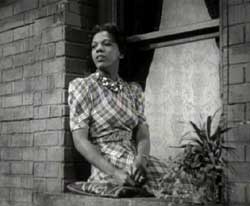 Ivie Anderson sings the title song I Got it Bad & That Ain't Good (1942) for Duke Ellington & His Orchestra. Ivie would like the Blanton-Webster Band would not be with Duke after this, & her wonderful performance can be considered a farewell. Ivie Anderson sings the title song I Got it Bad & That Ain't Good (1942) for Duke Ellington & His Orchestra. Ivie would like the Blanton-Webster Band would not be with Duke after this, & her wonderful performance can be considered a farewell.
Ivie's leaning from a window overlooking a rooftop where Duke & the Orchestra perform against a stylized cityscape backdrop.
As she sings the bluesy jazz number, the picture momentarily fades into a memory of the singer & her boyfriend at home, she adoring, he indifferent. This little reenactment is performed by Ivie & Duke Ellington himself.
Returning to the rooftop we see her man, who is none other than Duke, she finds him surrounded by babes as he plays his piano. Other band members are now slow-dancing with their gorgeous girlfriends, everyone in a moody mood.
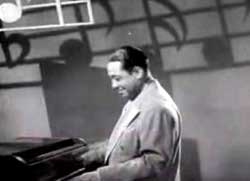 The song is called "Cottontail" but the soundie was titled Hot Chocolate (1941), putting the song title in parenthesis, this & Jam Session being rare example of a soundie not titled for the specific song.
The song is called "Cottontail" but the soundie was titled Hot Chocolate (1941), putting the song title in parenthesis, this & Jam Session being rare example of a soundie not titled for the specific song.
As this soundie opens, Duke Ellington & His Orchestra are performing at the Orpheum in a show called Jump for Joy, & we see the theater & its marquis all in lights.
The camera closes in on a poster outside the theater which boasts of others in the show, Ivie Anderson, Herb Jeffries, Big Joe Turner, Al Guster, & the wildly zoot suited trio of "Pot Pan & Skillet."
A few of these acts are preserved on separate Ellington soundies, including I Got It Bad & That Ain't Good featuring Ivie Anderson, Flamingo featuring vocalist Herb Jeffreys, & Bi-Blip with Marie Bryant & Paul White singing & dancing their hearts out.
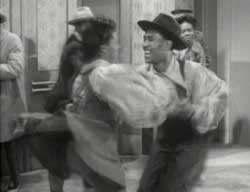 During the instrumentation for Hot Chocolate ("Cottontail") Ellington shouts out the name of Ben Webster just as Ben stands for his sax solo. We then see through the microphone connection to a radio audience which bursts into amazing dances. During the instrumentation for Hot Chocolate ("Cottontail") Ellington shouts out the name of Ben Webster just as Ben stands for his sax solo. We then see through the microphone connection to a radio audience which bursts into amazing dances.
This troupe is Whitey's Lindy Hoppers, who do acrobatic jiggerbug beyond fabulous. Herbert "Whitey" White founded this dance group in 1935 as regulars at the Savoy Ballroom, the greatest of Harlems great dance clubs, where black folk bumped shoulders with white folk in pre-integration times, the primary qualification for a big welcome being that you could dance.
Whitey selected his dancers right off the Savoy dance floor; it was veritably a nightly audition. he hired members of his troupe out to other clubs, including the Cotton Club, & rich folks hired them to spice up lavish private parties.
They were soon appearing in feature films besides a handful of soundies. The "second generation" of the troupe appears in Hot Chocolate which provides one more chance to see Whitey's Lindy Hoppers in action, making this soundie all the more importantly thrilling.
As an aside, the title of this soundie derives from Whitey's Lindy Hoppers having also been known as The Hot Chocolates.
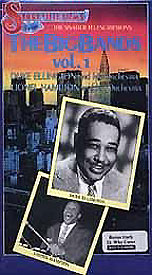 Two more Ellington telescriptions were spliced into the feature film release Rock & Roll Revue (1955) & reviewed on that page; namely they're The Mooche (1952) mispelled "Mooch" on the title card, & Louie Bellton's The Hawk Talks (1952). They were also part of Showtime at the Apollo: Revue in Rhythm (1955).
Two more Ellington telescriptions were spliced into the feature film release Rock & Roll Revue (1955) & reviewed on that page; namely they're The Mooche (1952) mispelled "Mooch" on the title card, & Louie Bellton's The Hawk Talks (1952). They were also part of Showtime at the Apollo: Revue in Rhythm (1955).
All the telescriptions except Solitude were recycled into sets of Snader & Studio telescriptions for syndication to television in half-hour bites, as trumped up concerts of sundry performers filmed between 1950 & 1954. These always added an emcee (Willie Bryant) & comedians to connect the mini-movies into a whole.
The soundtracks were tinkered with a bit to provide audience reactions & "curtains" were added, all designed to give the impression of concerts at the Apollo Theater, which though unconvincing has nevertheless fooled a lot of people ever since. Duke's portion were actually filmed at California Studios in Los Angeles.
Sophisticated Lady together with Mood Indigo were incorporated into a half-hour program for television Showtime at the Apollo: Blues in Harlem (1955). Caravan & V.I.P.'s Boogie were incorporated into Showtime at the Apollo: Harlem Merry-Go-Round (1955). These have resulted in two versions of each telescription making the rounds, with only those that preserve the original title cards not having their soundtracks mucked with.
All of the Ellington soundies can be had on a dvd compilation given as an "extra" along with a CD release collectively titled Duke Ellington: The Centennial Collection (2004), together with earlier Ellington shorts. His soundies are elsewhere scattered among miscellaneous soundie compilations.
copyright © by Paghat the Ratgirl
|
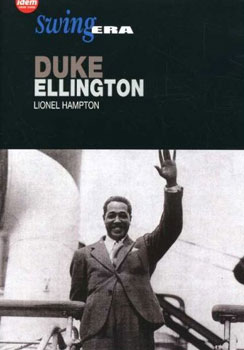

 Having an integrated band was actually chance-taking & daring at the time. It was outright illegal under Jim Crow laws in the south.
Having an integrated band was actually chance-taking & daring at the time. It was outright illegal under Jim Crow laws in the south.

 The Billy Strayhorn composition begins with an experimental rampage on Ellington's piano, then right into the slow melodic trombones (Quentin Jackson & Britt Woodman) & bass clarinet (Harry Carney).
The Billy Strayhorn composition begins with an experimental rampage on Ellington's piano, then right into the slow melodic trombones (Quentin Jackson & Britt Woodman) & bass clarinet (Harry Carney).
 Jam Session is a wonderful jukebox soundie with moments showcasing Ray Nance on violin, Rex Stewart on trumbone, Ben Webster on sax, Joe "Tricky Sam" Nanton on trombone with a toilet splunger for wah-wah effects.
Jam Session is a wonderful jukebox soundie with moments showcasing Ray Nance on violin, Rex Stewart on trumbone, Ben Webster on sax, Joe "Tricky Sam" Nanton on trombone with a toilet splunger for wah-wah effects.
 The crooner's vocal solo begins: "Flamingo, like a flame in the sky/ Flying over the island/ To my lover nearby."
The crooner's vocal solo begins: "Flamingo, like a flame in the sky/ Flying over the island/ To my lover nearby."
 When the camera jump-cuts back to a sax player, it's a different guy, Willie Smith, & he's playing alto sax, a rather a witty piece of editing since he's standing precisely where Carney had been standing.
When the camera jump-cuts back to a sax player, it's a different guy, Willie Smith, & he's playing alto sax, a rather a witty piece of editing since he's standing precisely where Carney had been standing.
 These poetic lyrics fit to an equally poetic melody. The song was written by Duke Ellington, Eddie De Lange & Irving Mills. It was also recorded by Billie Holiday, Sarah Vaughan & Johnny Mercer. Lyricist Eddie De Lange had also written "Moonglow" with Will Hudson while he helped head up the Hudson-DeLange Orchestra.
These poetic lyrics fit to an equally poetic melody. The song was written by Duke Ellington, Eddie De Lange & Irving Mills. It was also recorded by Billie Holiday, Sarah Vaughan & Johnny Mercer. Lyricist Eddie De Lange had also written "Moonglow" with Will Hudson while he helped head up the Hudson-DeLange Orchestra.


 During the instrumentation for Hot Chocolate ("Cottontail") Ellington shouts out the name of Ben Webster just as Ben stands for his sax solo. We then see through the microphone connection to a radio audience which bursts into amazing dances.
During the instrumentation for Hot Chocolate ("Cottontail") Ellington shouts out the name of Ben Webster just as Ben stands for his sax solo. We then see through the microphone connection to a radio audience which bursts into amazing dances.